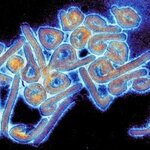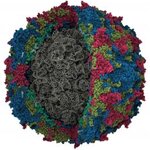Immunology

Researchers have developed a potential antibody therapy for Sudan ebolavirus (SUDV), one of the two most lethal strains of Ebola.
Sudan ebolavirus
was first identified in 1976 and has caused numerous Ebola outbreaks (most recently in 2012) that have killed more than 400 people in total.
A different strain, the Zaire ebolavirus (EBOV), is now devastating West Africa.
Between 30 and 90 percent of people infected with Ebola die after experiencing symptoms of the disease that include fever, muscle aches, vomiting and bleeding. In the current EBOV outbreak, at least 1,500…

Biofilms are the first line of defense for harmful bacteria and make the treatment of skin infections especially difficult because microorganisms protected in a biofilm have antibiotic resistance and recalcitrance to treatment.
Biofilm-protected bacteria account for some 80 percent of total bacterial infections in humans and are 50 to 1,000 times more resistant to antibiotics than simpler bacterial infections.
Biofilms often persist in the periphery of an actual wound, beneath an intact, healthy skin layer and the difficulty of their treatment is largely due to the outermost…
In the 14th century, Venice was in many ways still a world power in its own right. The days when it could topple kingdoms using commerce were behind it, but it was still an important trade destination. In that period, trade meant ports and ports meant the Bubonic Plague in 1347.
When it hit, some tried prayer, some tried hunting vampires, but then officials quickly began to utilize what we would now call resilience management: rather than trying to target a poorly understood risk, state authorities focused on managing physical movement, social interactions, and data…

Researchers at
the NIH National Institute of Allergy and Infectious Diseases scientists have found that Middle East respiratory syndrome coronavirus (MERS-CoV) infection in marmosets closely mimics the severe pneumonia experienced by people infected with MERS-CoV, giving researchers the best animal model yet for testing potential treatments.
They used marmosets after predicting in computer models that the animals could be infected with MERS-CoV based on the binding properties of the virus.
The same NIAID group in December 2012 developed the first animal model of MERS-CoV infection…

Thanks to effective vaccination, polio is nearly eradicated and only a few hundred people are stricken worldwide each year.
But researchers in PNAS have reported alarming findings: a mutated virus was able to resist the vaccine protection to a considerable extent in the Congo in 2010. The pathogen could also potentially have infected many people in Germany.
The polio epidemic in the Congo in 2010 was especially serious. 445 people were verifiably infected, mostly young adults. The disease was fatal for 209 of them. This high mortality rate is surprising. Also important was the…

People allergic to milk often assume they have lactose intolerance, but they are actually different mechanisms that occur in different parts of the body.
People with lactose intolerance do not digest lactose properly because they lack an enzyme known as lactase - and that results in digestive discomfort. A cow milk allergy is much more dangerous because the body's immune system attacks milk proteins with its own IgE antibodies.
According to statistics, up to 2-3 percent of children in Europe suffer from an actual milk allergy, though it often disappears in adulthood. In…

Tekmira Pharmaceuticals and collaborators at the University of Texas Medical Branch at Galveston, have protected nonhuman primates against Marburg virus, also known as Angola hemorrhagic fever.
There are currently no vaccines or drugs approved for human use and no post-exposure treatment that has completely protected nonhuman primates against MARV-Angola, the most deadly Marburg viral strain, with a mortality rate of up to 90 percent. This virus, which is in the same family as Ebola, has a rapid disease course (seven to nine days) in nonhuman primates. There have been two recent imported…

Among the popular mythologies built up around native American cultures is that they had no disease before Europeans arrived full of pathogens. It's a common narrative in anthropology, it just was never science.
A new study documents that again, finding isolated Mycobacterium pinnipedii from skeletons found in Peru which are at least 1000 years old. The pathogen is a relative of the TB bacterium that affects seals, so it likely that seals carried the pathogens from Africa to the Peruvian coast.
Tuberculosis remains a global threat. New drugs and vaccines are urgently needed to fight this…

In a world that is constantly changing, are attempts to eradicate disease realistic?
Over 40 years ago, researchers were happy to have a War on Cancer. President Richard Nixon made it a national priority and it came with a lot of funding, so no one corrected what became an obvious point decades and billions of dollars later; you can't cure cancer.
Efforts at eradicating diseases may be doomed because of a mismatch between the ways humans structure the world and the ways pathogens move through the world, according to a paper in The Lancet Infectious Diseases. Polio is the poster child for…

Scientists have altered key biological events in red blood cells, causing the cells to produce a form of hemoglobin normally absent after the newborn period.
Because this hemoglobin is not affected by the inherited gene mutation that causes sickle cell disease, the cell culture findings may give rise to a new therapy for the debilitating blood disorder. Their approach uses protein-engineering techniques to force chromatin fiber, the substance of chromosomes, into looped structures that contact DNA at specific sites to preferentially activate genes that regulate hemoglobin.
"We have…